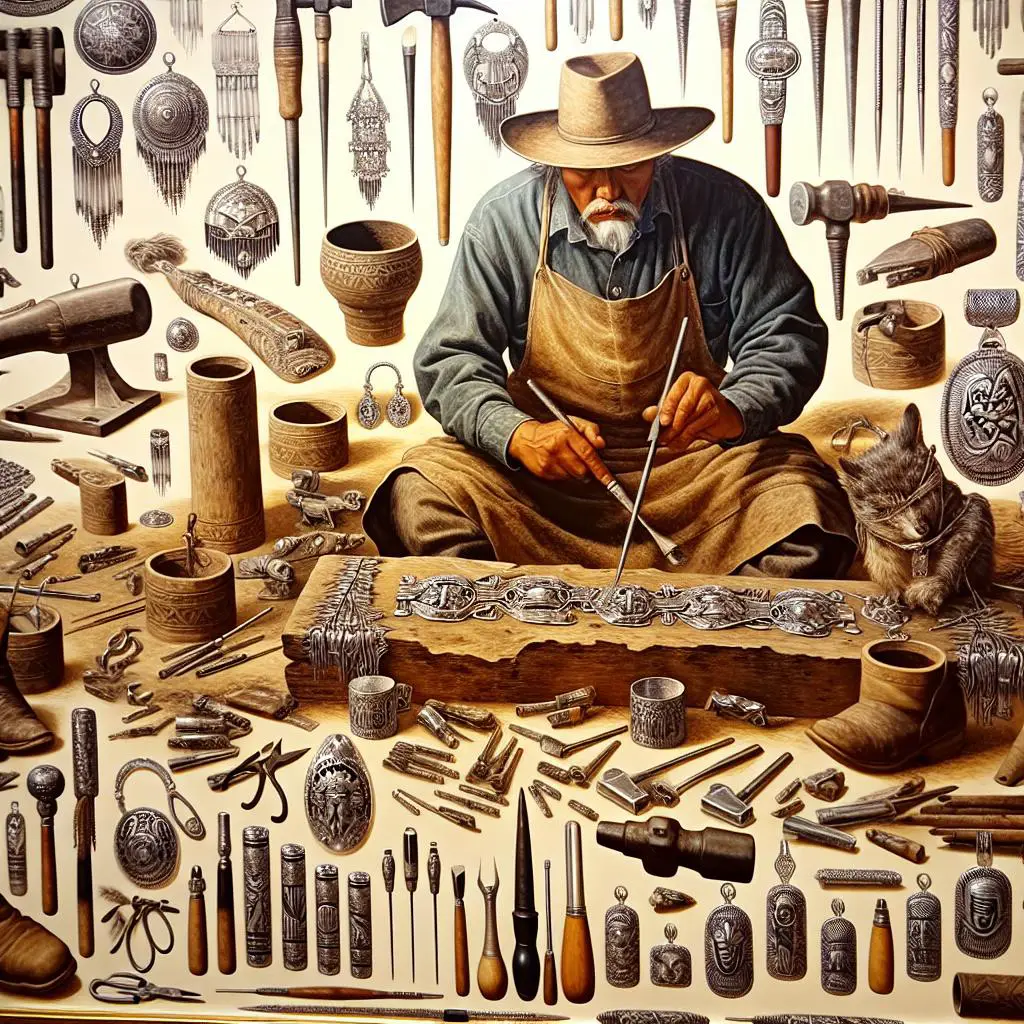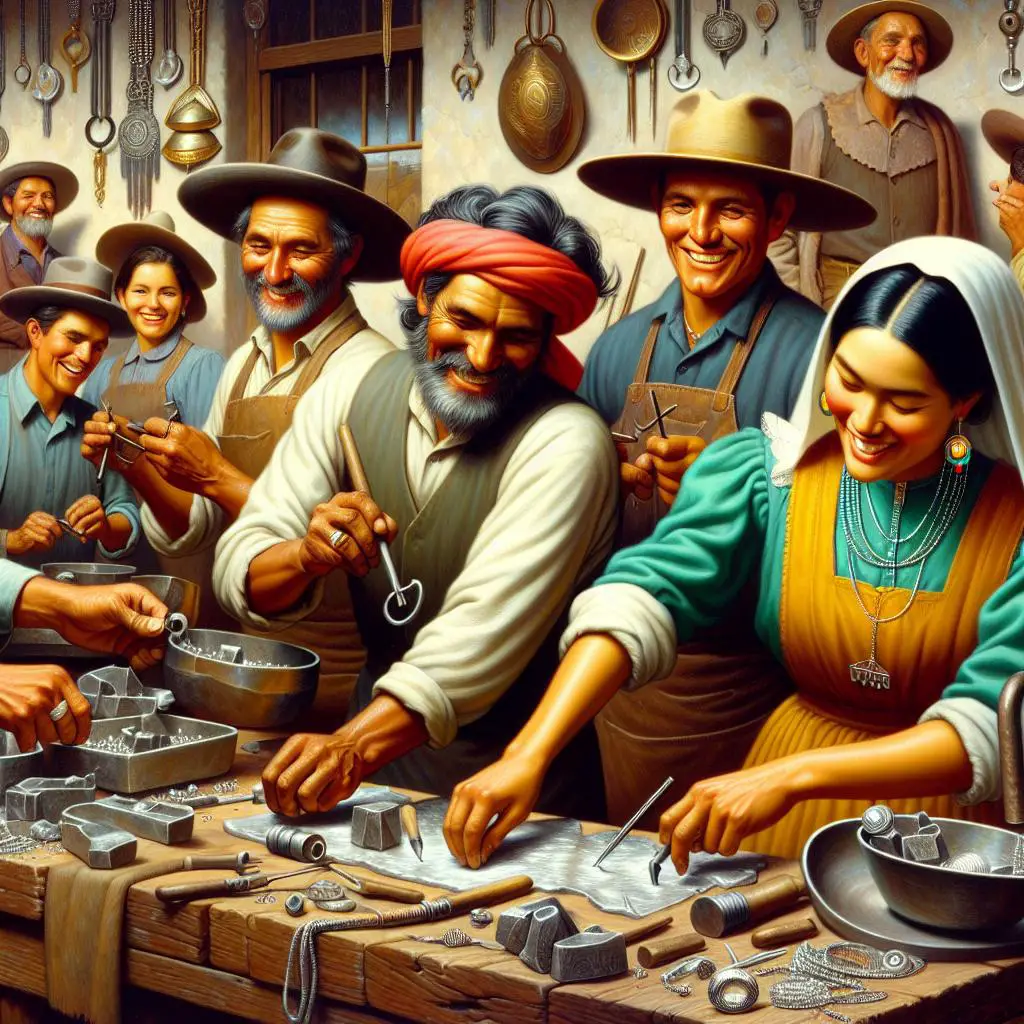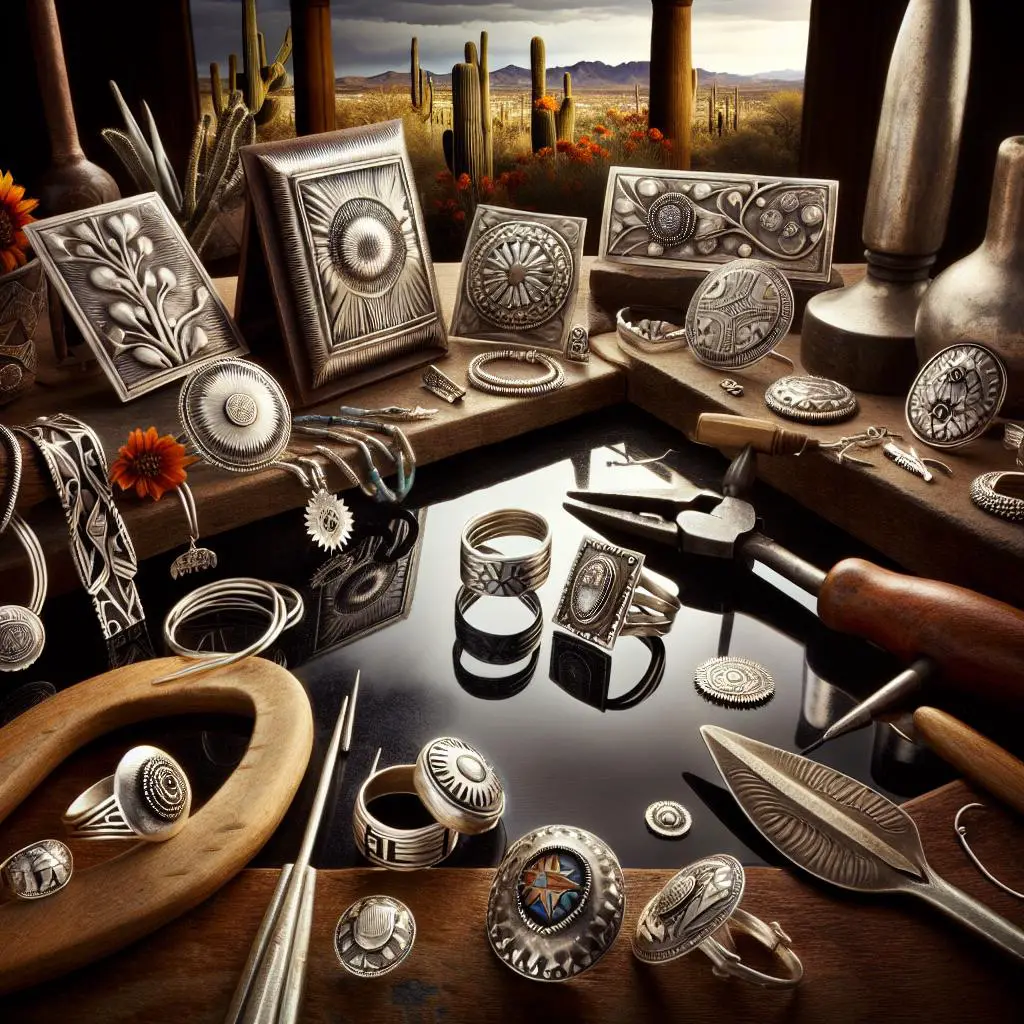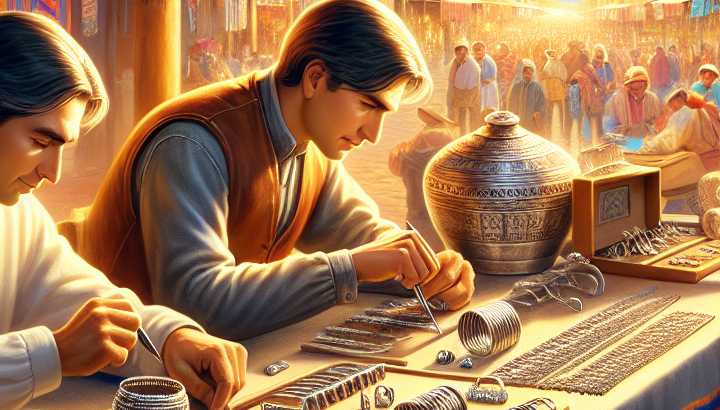Silver Crafting Traditions in the Southwest

Historical overview of southwestern silver crafting
Picture this: You’re meandering your way through the dusty, sun-drenched trails of the Southwestern United States. The air is fragrant with the scent of sagebrush, the yucca plants cast peculiar shadows, and the vibrant sunset feels like an artist smearily drawing out the sky with a brush dipped in oranges and purples. Suddenly, you spot something half-buried in the sandy soil – it’s shiny, ornate, and immediately captivating. Congratulations! You’ve just stumbled upon a piece of Southwest silver crafting history.
Now, hold onto your cowboy hats, folks. We’re about to embark on a rip-roaring, tumbleweed-tossing, bust-down-the-saloon-doors journey through the captivating and intricate history of Southwestern silver crafting.
We start our wild wagon ride in the mid-19th century. Up until that point, the Native American tribes of the Southwest had been shaping and fashioning jewelry from turquoise, shell, and stone for centuries – picture a prehistoric Prada, if you will. But a shiny new player was about to enter the stage in the form of a Spanish blacksmith named Atsidi Sani, also known as Old Smith.
Armed with the skills and techniques taught to him by the Spanish monks, Sani introduced his Navajo kinsfolk to the world of silversmithing in 1850. And let me tell you, folks, these Navajo artisans took to silver like a coyote to a roadrunner! They began hammering out crosses, earrings, belt buckles, bracelets – if they could wear it, they crafted it!
The 1880’s brought forth an avalanche of railroad-built convenience and a trove of American settlers into this southwestern wonderland. An effect akin to smelting silver ore in a hot pit of selling opportunities! This, my friends, is when the illustrious turquoise began to add its delightful dash of color to the artistry of silver. The very thought of it makes my spurs tingle!
Navajo silver, with its signature bold patterns and chunky shapes, sort of like Clint Eastwood wearing an oversized sombrero, began to take center stage.
“Piles of clothing, shoes, curtains, blankets, baskets of silver, packages of groceries, a confusion of all sorts of things blocked the doorway; but Mrs. Stewart greeted them as calmly as if she were in her reception room receiving the neighborhood”
~ Emilie Benson Knipe and Alden Arthur Knipe, Illustrated by Emilie Benson Knipe , ’64
Because, honestly, in the land of the Southwest, bigger is often most definitely better!
The turn of the century brought the Zuni Pueblo artists dancing into the mix. They incorporated intricate stone inlays, creating pieces with super-tight stonework, vibrant colors, and complex patterns. Imagine a teeny, tiny mosaic tailor-made for your wrist or finger, fitting perfectly, like a cowboy’s snug hand in a well-worn leather glove.
The Hopi folks then decided to add their silver-soaked stamp on the scene. They adopted a distinct overlay technique, creating complex designs and religious motifs. Picture a medieval tapestry, but carved skillfully into a piece of blinkin’ silver!
Today, Southwestern silver crafting is a hot tamale of design and creativity, a banging blend of the historical techniques and the modern twists. It’s still handcrafted, it’s still authentic, and it certainly is a piece of history you can wear. The cowboys may have ridden off into the sunset, but the legacy of Southwestern silver crafting — like a prickly cactus in the desert — stands firm and proud, continuing to captivate jewelry lovers worldwide.
So, the next time you’re strolling through a bustling Southwestern market, and a shimmering silver piece catches your jauntily squinting eye, you’ll know you’re not just looking at a piece of jewelry. You’re seeing centuries of tradition, craftsmanship, culture, and history, all entwined in that gleaming, ornate piece of Southwestern silver craftsmanship. How’s that for striking gold, I mean, silver? Yeehaw!
Read More: Historical Overview Of Southwestern Silver Crafting

Important figures in southwestern silver crafting
The Southwest U.S. has a reputable and colorful history in silver crafting, boasting some real characters whose legacy is as lustrous as the metals they morphed. Buckle up, you’re about to traipse down a silver-laden memory lane.
First off, let’s dive into the delightful story of Fred Harvey. If you’re thinking, “Wait, wasn’t he the dude who revolutionized the railroad industry by opening eateries along routes?” Well, you’re right, but our Fred wasn’t just a fat steaks-and-greasy-spoons kind of guy. He was also pivotal in popularizing Southwest Native American jewelry, particularly those mouthwatering silver goodies.
Without an ounce of exaggeration, Fred Harvey was the Southwest’s Beyoncé of the late 1800s and early 1900s — except instead of selling chart-topping hits, he peddled silver en masse. Fred, in his high-waisted trousers and well-kept ‘stache, encouraged Native Americans to craft their jewelry in ways appealing to Euro-American tastes. His company’s output, dubbed ‘Fred Harvey Jewelry,’ still mirrors a time when East met West in a whimsical flurry of silver, turquoise and railroad romance.
Next up, we have Charles Loloma, or as we like to call him, the Picasso of Indian Jewelry. This Hopi kachina doll carver-turned jewelry mastermind took silver crafting into realms yet uncharted. With his creative prowess faster than a roadrunner in a desert, Charles Loloma infused traditional Hopi silverwork with contemporary perspectives.
Bold, audacious, and scarcely sticking within the boundaries of traditional, his jewelry pieces looked like they were brewed in a kaleidoscope.
“In the indistinct light the figures of mounted men could be seen moving like shadows among the trees”
~ Lucy Foster Madison, Peggy Owen Patriot
Combining vibrant gemstones with silver, Loloma unveiled a fresh aesthetic that said, “Adios old norms, Hola new bling!” His work broke barriers, redefined Native American jewelry, and made people sit up straight at craft shows.
Then there’s the kingpin of Navajo silversmithing, Kenneth Begay. Known as the “Master Silversmith,” Kenneth’s potpourri of designs had the Southwest saying, “Boy howdy!” His pieces — sleek, modern, and downright sexy — amalgamated the minimalistic elements of the Mid-century Modern aesthetic with Navajo traditions.
Kenneth’s designs were a far cry from the chunky, rugged designs that waltzed around in the Southwest. He made the most elegant cufflinks, bracelets, brooches, and belt buckles the West had ever set its cowboy-hatted head on. His major contribution was proving that traditional Native American silverwork could also be distilled into delicate finesse.
And where would we be without a mention of the phenomenal innovator, innovator’s innovator, the Indiana Jones of silversmiths – Hopi artist, Preston Monongye. From his hands, ordinary lumps of silver transformed into abstract expressions of Native American folklore. Preston explored modernistic designs, integrated exotic materials like fossilized ivory and dinosaur bone (yes, you read that right!), shattering all stereotypes about Southwestern silver crafting.
In conclusion, these are just a few of the influential names that have shimmered on the Southwestern silver crafting stage. Hats off to these artists who, with their visionary skills, shaped a shining and illustrious legacy that continues to inspire and delight. So, next time you gawk at a breathtaking piece of Southwestern silver, remember the gritty hands and brilliant minds that have turned this humble metal into wearable masterpieces. Here’s to the mavericks of Southwestern silver crafting! Or as they say in the Southwest, “Yeehaw!”
Like This? Try: Important Figures In Southwestern Silver Crafting

Modern influences on southwestern silver crafting
It’s high noon in the wild, wild world of southwestern silver crafting, and there’s a shootout on the horizon. Like any good western narrative, change is afoot. Buckle up, partner, as we ride into the sunset and explore the modern influences sweeping this traditionally steeped industry off its trusty steed.
Our tale begins in the rugged landscape of the American Southwest. Indigenous nations like the Navajo, Hopi, and Zuni originally pioneered the art of silver crafting. These expert artisans, using the prongs of cactus, transformed silver coins into dazzling works of wearable art. From intricate necklaces that shimmered brighter than the desert sun, to bracelets and bangles that sang with every move of the hand, these pieces carried and narrified the cultures’ rich folklore, spirituality, and iconography.
But lo and behold, times are a-changin’. It’s 2022, not 1822! Silver crafting, like a patient mule-toeing prospector, has harnessed new influences and techniques, refusing to be left in the tumbleweed of the analog world.
First off, we’ve seen the digital gold rush invade this southwestern territory. Picture yourself sitting by a cozy fire, squinting at your smartphone screen, sipping whatever cactus juice concoction the internet told you was healthy this week, all while shopping for exceptional silver pieces online. Welcome to the wonders of ecommerce, you modern cowboy, you!
More than ever, consumers can explore and purchase authentic southwestern silver jewelry without venturing out into the vast, dusty expanse. This has created a new era of accessibility, transforming once-remote craftsmen into international sensations overnight.
Moreover, flashy (literally) technologies like 3D printing and laser engraving are revolutionizing how pieces are made.
“=THE TEACHER.= Moral Influences Employed in the Instruction and Government of the Young”
~ John G. Edgar, The Wars of the Roses
Gone are the days when silversmiths toiled away with hammers and anvil, the rhythmic clang echoing across arid canyons. Instead, today’s artisans might well be found wrestling with file uploads, software hiccups, and printer jams. It’s a modern-day duel at high noon.
And let’s not forget sustainability, a trend that galloped into the mainstream. Justifiably so, considering our planet is more precious than the shiniest silver nugget. Consumers are championing sourcing and refinement practices that respect Earth’s bounty right alongside the skillful hands crafting the pieces. This has seen many an artisan moving to ethical mining or recycled silver, as clear a sign as any of the changing tides.
Yet, amidst all this modern hoo-ha, the heart of southwestern silver crafting remains resolute. Even as artisans embrace these innovations and new markets, their work continues to echo with the pulses of time-honored tradition. Through their passion, the storied legacy of their ancestors rumbles on, a reassuring hum in the background of the industry’s progressive jazz tune.
From dollar coins pounded against crude anvils to intricate designs laser-etched by complex machinery, we are witnessing a fantastical fusion of the ancient and the contemporary. It’s a bit like a cowboy film directed by Spielberg – innovative yet nostalgic, simultaneously.
So, friends, as the sun sets on our trip through the changing terrain of southwestern silver crafting, remember this: the next time you don your glimmering turquoise pendant or intricately etched cuff, you’re wearing not just a piece of jewelry, but a showcase of a culture’s journey through time. From cactus prongs to printer jams– ain’t that a ride?
Enjoyed This? Here’s More: Modern Influences On Southwestern Silver Crafting
